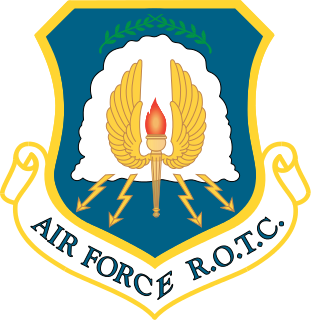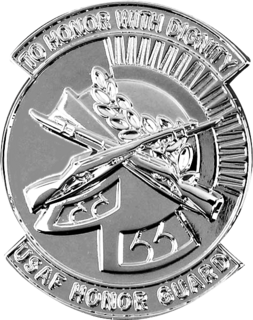
The Fleet Marine Force Ribbon, officially the Navy Fleet Marine Force Service Ribbon, was a military award of the United States Navy established in 1984 by Secretary of the Navy, John F. Lehman, Jr. The service ribbon was awarded to eligible Navy personnel serving with the Marine Corps between 1984 and 2006. The award signified the acquisition of specific professional skills, knowledge and military experience that resulted in qualifications above those normally required of Navy personnel serving with the Fleet Marine Force (FMF). The FMF Ribbon was discontinued in the mid-2000s due to the promulgation of the FMF badges.

The Parachute Rigger Badge is a military qualification badge of the United States Army and the United States Air Force which was first created in 1948 and officially approved in June 1986. The award is intended as a badge for enlisted, warrant officer and officer personnel who have successfully completed parachute rigger courses specified by the U.S. Army Quartermaster Center and School.

A parachutist badge is a military badge awarded by the armed forces of many states to soldiers who receive the proper parachute training and accomplish the required number of jumps. It is difficult to assess which country was the first to introduce such an award.

The Military Freefall Parachutist Badge is a military badge of the United States Army and United States Air Force awarded to qualified U.S. Army and U.S. Air Force personnel as high-altitude military parachute specialists.

The Recruiter Badge is a decoration of the United States uniformed services that is awarded to personnel who have performed recruitment duties as service recruiters. The Recruiter Badge is issued by every branch of the U.S. uniform services except for the U.S. Marine Corps and the NOAA Commissioned Corps. With the exception of the U.S. Army, a Recruiting Service Ribbon is also awarded to those personnel who have completed successful tours as uniform service recruiters.

The U.S. military issues instructor badges to specially training military personnel who are charged with teaching military recruits the skills they need to perform as members of the U.S. Armed Forces or teach continuing education courses for noncommissioned officers and officers in the military. With the exception of the U.S. Army and U.S. Coast Guard, these badges are considered temporary military decorations and must be surrendered upon completion of one's duty as a military instructor. Because of this, the U.S. Air Force, U.S. Navy, and U.S. Marine Corps award Drill Instructor Ribbons as a permanent decoration to recognize service members who have qualified and performed as military instructors.

The Air Force Reserve Officer Training Corps (AFROTC) is one of the three primary commissioning sources for officers in the United States Air Force and United States Space Force, the other two being the United States Air Force Academy (USAFA) and Air Force Officer Training School (OTS). A subordinate command of the Air University within the Air Education and Training Command (AETC), AFROTC is aligned under the Jeanne M. Holm Center for Officer Accessions and Citizen Development at Maxwell AFB, Alabama. The Holm Center, formerly known as the Air Force Officer Accession and Training Schools (AFOATS), retains direct responsibility for both AFROTC and OTS.

The Flight Nurse Badge is a military badge of the United States armed forces which is issued by the U.S. Air Force and United States Navy to flight nurses. Versions of this badge have existed since World War II, when the decoration was first created as the Army Air Forces Flight Nurse Badge.
The Missile Badge is a military decoration of the United States Air Force which was first created on 23 May 1958. The "pocket rocket" badge recognizes those commissioned officers and enlisted personnel of the US Air Force who have qualified as missile personnel that have been trained in the maintenance or launching of land-based and air-launched nuclear weapons under the direction of the National Command Authority. Originally known as the Missileman Badge, the Missile Badge later became known as the Missileer Badge or more informally the Pocket Rocket and is still often referred to by this name.

The Parachutist Badge, also commonly referred to as "Jump Wings" is a military badge of the United States Armed Forces. The United States Space Force and United States Coast Guard are the only branches that do not award the Parachutist Badge, but their members are authorized to receive the Parachutist Badges of other services in accordance with their prescribed requirements. The DoD military services are all awarded the same Basic Parachutist Badge. The U.S. Army and U.S. Air Force issue the same Senior and Master Parachutist Badges while the U.S. Navy and U.S. Marine Corps issue the Navy and Marine Corps Parachutist Badge to advanced parachutists. The majority of the services earn their Basic Parachutist Badge through the U.S. Army Airborne School.

Insignias and badges of the United States Navy are military badges issued by the United States Department of the Navy to naval service members who achieve certain qualifications and accomplishments while serving on both active and reserve duty in the United States Navy. Most naval aviation insignia are also permitted for wear on uniforms of the United States Marine Corps.

Badges of the United States Air Force are specific uniform paraphernalia authorized by the United States Air Force that signify aeronautical ratings, special skills, career field qualifications, and serve as identification devices for personnel occupying certain assignments.
The Air Force Specialty Code (AFSC) is an alphanumeric code used by the United States Air Force to identify a specific job. Officer AFSCs consist of four characters and enlisted AFSCs consist of five characters. A letter prefix or suffix may be used with an AFSC when more specific identification of position requirements and individual qualifications is necessary. The AFSC is similar to the Military Occupational Specialty Codes used by the United States Army and the United States Marine Corps or enlisted ratings and USN officer designators and Naval Officer Billet Classifications (NOBCs) used by the United States Navy and enlisted ratings and USCG officer specialties used by the United States Coast Guard.

The United States Air Force Honor Guard Badge is a military badge of the United States Air Force that is authorized for wear by all personnel who are assigned to the United States Air Force Honor Guard ,or to active members of a Base Honor Guard (BHG). For males, the badge is worn as a decoration centered on the left uniform pocket, below standard awards and decorations. For females, it is worn on the right side, even with the bottom of their decorations.
The Aircrew Badge, commonly known as Wings, is a qualification badge of the United States military that is awarded by all five branches of armed services to personnel who serve as aircrew members on board military aircraft. The badge is intended to recognize the training and qualifications required by aircrew of military aircraft. In order to qualify as an aircrew member and receive the Aircrew Badge, such personnel typically undergo advanced training in aircraft in-flight support roles.

U.S. Air Force aeronautical ratings are military aviation skill standards established and awarded by the United States Air Force for commissioned officers participating in "regular and frequent flight", either aerially or in space, in performance of their duties. USAF aeronautical badges, commonly referred to as "wings" from their shape and their historical legacy, are awarded by the Air Force in recognition of degrees of achievement and experience. Officers earning these badges and maintaining their requirements are classified as rated officers and receive additional pay and allowances.

Airman first class (A1C) is the third enlisted rank in the United States Air Force, just above airman and below senior airman. The rank of Airman First Class is considered a junior enlisted rank, with the non-commissioned officers and senior non-commissioned officers above it.

The 1st Air Support Group of the Puerto Rico State Guard (1ASG-PRSG) — is the main unit of the State Guard of the Military Forces of Puerto Rico that operates under the sole authority of the governor of Puerto Rico who, in turn, delegates such authority to the Puerto Rico Adjutant General and to the Commanding General of the Puerto Rico State Command.
The Space Operations Badge is an occupational badge for guardians of the United States Space Force and space airmen of the United States Air Force while the United States Army (USA) version of the badge, known as the Space Badge, is a special skills badge for soldiers who qualify as space professionals.

Badges of the United States Space Force are specific uniform paraphernalia authorized by the United States Space Force that signify ratings, special skills, career field qualifications, and serve as identification devices for personnel occupying certain assignments. Space Force occupational badges are awarded in three degrees or skill levels. Badges for space operations are awarded at basic, senior, and command levels; other occupational badges are issued in basic, senior, and master level. A star and wreath system, worn above the badge, denotes which degree or skill level a service member currently holds.
















